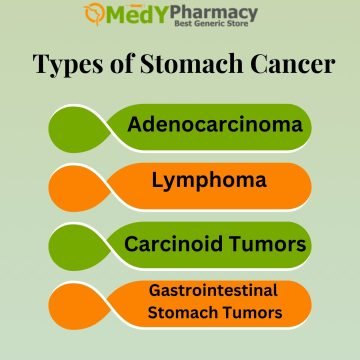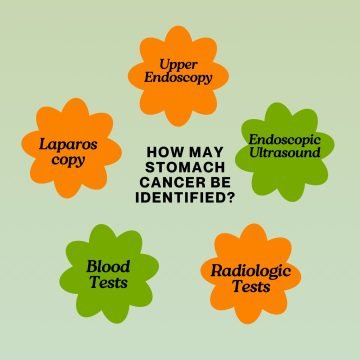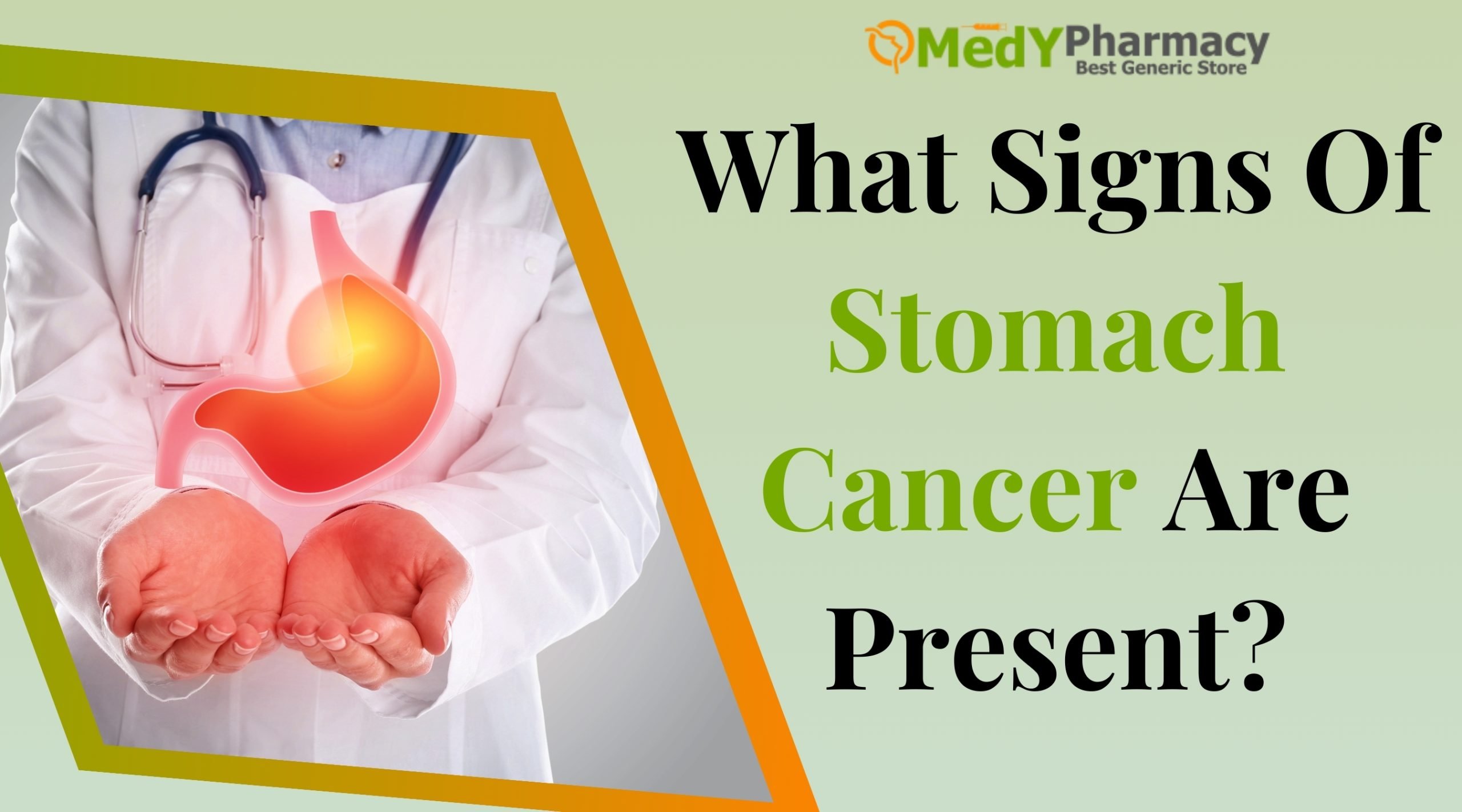Introduction:
Almost of stomach cancers begin in the stomach’s lining glandular tissue. Depending on whether it grows through the stomach wall or spreads along it, the tumor may release cells into the lymphatic or circulatory systems. Cancer can spread to other organs after leaving the stomach.
These are categorized based on the tissue type in which they first appear. The glandular gut lining is where adenocarcinomas, the most prevalent, begin.
Blood cells called lymphocytes, which are part of the immune system, give rise to lymphomas. The connective tissue is affected by sarcoma.
Other varieties include squamous cell carcinoma, small cell carcinoma, and carcinoid carcinoma. The stomach can potentially develop metastases from original cancer locations, such as breast cancer and melanoma.
Understanding the signs of this may help you and your physician identify it early when treatment is most straightforward.
Any area of the stomach might be the initial site of this tumor. Among these symptoms include exhaustion and frequent burping.
It ranks third in terms of cancer-related mortality and is the sixth most prevalent kind of cancer globally.
Adenocarcinomas, also known as gastric carcinomas, account for 90–95% of all stomach malignancies. This kind of cancer arises from cells that grow in the mucosa. This is the stomach lining where mucus is produced.
The risk factors for stomach cancer are covered in this article along with information on how to identify, diagnose, and treat the disease.
What Is Stomach Cancer?
This type of cancer, also known as gastric cancer, is caused by the unchecked growth of cancer cells in the stomach. Anywhere in your stomach, cancer can develop. Abnormal cell development at the junction of the stomach and esophagus is a common feature of stomach cancer in the United States. The primary stomach region is often where gastric cancer develops in other nations where the disease is more prevalent.
This begins slowly in the lining of your stomach in around 95% of cases. If left untreated, it may expand further into your stomach walls and develop into a mass (tumor). The tumor may expand to your pancreas and liver, among other neighboring organs.
Neuroendocrine tumors, gastrointestinal stromal tumors, lymphomas, and small cell carcinomas are uncommon forms of stomach cancer.
This happens when the stomach lining becomes infected with malignant cells. Gastric cancer is another name for this form of cancer, and because most people don’t exhibit symptoms in the early stages, it can be challenging to detect. It frequently remains misdiagnosed until it has spread to other bodily areas as a result.
Gaining the knowledge necessary to manage the condition is crucial, even though diagnosis and treatment can be challenging.
The Impact of Stomach Cancer
This type of cancer is sometimes referred to as gastric cancer, and as the name implies, it affects the stomach. When someone has stomach cancer, a tumor develops and grows inside the stomach.
The stomach body, also known as the mid-regions, is where the tumor usually occurs, however it can occur elsewhere in the stomach. If this is detected early and the tumor has developed inside the stomach, it is probably treatable.
- The male was your birth ascribed to gender.
- You are of Eastern European, South or Central American, or East Asian ethnicity.
Reviews of patients who have had therapy for stomach cancer are positive, and the condition has been cured.
However, if your stomach problem is discovered later, there’s a good possibility the tumor has already become cancerous and might spread to other regions of your body very fast.
Tumors that develop on the stomach’s outer layer are difficult to treat in addition to this kind of malignancy.
- Normal Digestion
An important part of food digestion is done in the stomach. When this mechanism is disrupted, symptoms including nausea, vomiting, and trouble swallowing may result. Food passage may become difficult due to partial or total blockage caused by tumors that block the stomach or its exit.
- Pain and Discomfort
Even with little food intake, the tumor may induce pain or a sense of fullness as it develops. The size and location of the tumor will determine how severe the discomfort is.
- Nutritional Deficiencies
Unintentional weight loss may occur because of the stomach’s impaired capacity to digest meals. Nutritional shortages may eventually result from this, which can be made worse by decreased appetite and trouble absorbing nutrients.
- Bleeding and Anemia
Internal bleeding from this might result in anemia. Although the blood loss may not always be visible, it can occasionally occur gradually in small amounts and result in weakness, pallor, and exhaustion.
- Metastasis to Other Organs
As the cancer progresses, it may spread to other organs such as the liver, lungs, or adjacent lymph nodes, making therapy more difficult and producing more symptoms associated with those organs.
- Digestive Enzyme
The synthesis of digestive enzymes and stomach acid may be impacted by stomach cancer, which might result in poor digestion. After eating, this may exacerbate symptoms including indigestion, bloating, and discomfort.
The prognosis is dependent on the stage of the disease upon diagnosis, and the treatment for this often consists of radiation, chemotherapy, surgery, or a combination of these. Treatment and management prospects are better the sooner it is identified.
Does Your Stomach Cancer Feel Like It Has A Tumor?
During a physical examination, your doctor might be able to feel a tumor in your stomach, depending on how advanced the cancer is. But more frequently than not, symptoms include identifying stomach feelings. Your stomach may feel uncomfortable, full, or bloated all the time. As the illness worsens, the initial level of discomfort may decrease and then increase.
An aching in the upper abdomen or around the stomach that is dull or persistent is one of the more obvious symptoms. A lump or a hard spot that hurts or feels uncomfortable to the touch might indicate a malignancy.
A tumor or other condition interfering with the stomach’s natural function may be the cause of your frequent bloating and pain or unexpected fullness after consuming only tiny amounts of food.
Cancer or other stomach problems may be the cause of your regular nausea or complete lack of appetite.
Acid reflux, heartburn, or persistent indigestion that doesn’t go away might occasionally be associated with stomach cancer, especially if it’s more severe than usual or worsens over time.
Even while a lump may not necessarily be a sign of cancer, it’s nevertheless crucial to get any hard masses or lumps in the upper abdomen looked out. Similar feelings may be caused by other illnesses, such as stomach ulcers or benign growths.
Though they may indicate cancer, these symptoms might also be caused by less serious illnesses like gastritis, ulcers, or even an infection. It is advisable to seek an examination from a healthcare professional if you are experiencing concerns. They can conduct tests to obtain the right diagnosis and rule out dangerous illnesses.
How the Stomach Cancer Functions
Food enters the stomach through the esophagus. After that, the stomach breaks down and stores the food for our body to absorb. To make the meal easier to digest, it produces gastric juice, which combines with the food.
The stomach’s inner lining contains glands that produce gastric juice. It contains a protein known as pepsin, water, and stomach acid. We smell something, and it starts to flow. The meal becomes a thick liquid as the stomach muscle contracts, churning it with the juice. It takes a few hours for this to occur. The liquid then travels to the colon, where it is absorbed by the body.
Even when this is empty, hormones and gastric juice are still produced. To shield the stomach lining from the acid and pepsin, it also creates a thick mucus.
A muscle valve known as the lower esophageal sphincter (LES) allows food to pass from the esophagus into the stomach while eating. Around 1.5 liters of food and drink may be held in the stomach at once, and food is first briefly stored there for later breakdown.
To combine food with digestive fluids, the smooth muscles lining the stomach walls contract and churn. A semi-liquid material is created when food is broken down into tiny pieces by this mechanical process.
Food is progressively discharged into the small intestine through the pyloric sphincter, a valve that regulates the passage of partially digested food until it has sufficiently broken down into chime. For the small intestine to absorb nutrients and digest food as best it can, the release is done gradually.
This is quite effective at handling this intricate process, making sure that food is adequately broken down before it proceeds to the intestines for further digestion and nutritional absorption.
Types of Stomach Cancer
Let’s review the many forms of stomach cancer. The area of the stomach where the tumor starts to grow or the cells it has impacted determines this division.

- Adenocarcinoma
The glandular cells that create and discharge fluids or mucus are the source of this particular sort of cancer. This kind of cancer can develop in the stomach, colon, lungs, esophagus, and pancreas, among other places. In the case of stomach cancer, it is precisely known as gastric adenocarcinoma.
The cells that produce mucus, digestive juices, or hormones are called glandular cells, and they are located in the lining of organs. These stomach lining glandular cells are impacted when gastric cancer occurs.
The stage of stomach adenocarcinoma at diagnosis has a significant impact on the prognosis. Since there are no symptoms in the early stages, it can be difficult to diagnose, but the chances of effective treatment and long-term survival are better if discovered early. The prognosis is usually worse if the condition is discovered at an advanced stage, although therapies can still help control the symptoms.
- Lymphoma
This kind of cancer starts in the lymphatic system, which is a component of the immune system and comprises organs such as the bone marrow, spleen, thymus, and lymph nodes. Usually, lymphocytes—a subset of white blood cells that aid in the body’s defense against infections—are impacted by the malignancy.
This is a more varied category of malignancies that can develop in bone marrow, the spleen, or other lymphatic tissues. No Reed-Sternberg cells are involved.
Depending on the disease’s stage and kind, lymphoma prognoses vary. After therapy, many individuals with Hodgkin lymphoma go on to have long, healthy lives, and the disease has a comparatively high cure rate, particularly if detected early.
The prognosis for non-Hodgkin lymphoma varies greatly because some forms are difficult to treat and develop slowly, while others are more aggressive. All things considered, improvements in treatment, including immunotherapy and targeted medicines, have greatly raised the survival rates of both forms of lymphoma.
- Carcinoid Tumors
For patients with carcinoid tumors, the prognosis varies. Early identification and treatment can improve the prognosis for many carcinoid tumors, which develop slowly. The outlook could be less favorable, though, if the tumor has spread. For people with metastatic illness, the 5-year survival rate may vary depending on how well the tumor responds to treatment, although it is generally high for circumscribed carcinoid tumors.
There are treatments to control the symptoms and enhance quality of life, but the presence of carcinoid syndrome frequently signifies that the tumor is further advanced. The detection of any recurrence or consequences from the tumor or its treatment depends on routine monitoring and follow-up care.
If you have symptoms such as flushing, unexplained diarrhea, or other indications of carcinoid syndrome, it’s critical to see a healthcare professional since early identification and treatment are essential for a better prognosis.
- Gastrointestinal Stomach Tumors
Tumors of the gastrointestinal (GI) tract are any abnormal growths or masses that develop in the stomach. These tumors may be cancerous or benign. Gastric cancer refers to malignant tumors that develop in the stomach; adenocarcinoma is the most prevalent kind of gastric cancer. The stomach can also develop several benign growths, however these are far less often.
This kind of neuroendocrine tumor can grow in the stomach. These tumors frequently develop slowly and may release hormones that cause symptoms like diarrhea and flushing. Sometimes, medications that target cancer cells specifically are used to treat stomach cancer. Drugs that target growth factors or the tumor’s blood supply fall under this category.
The prognosis is contingent upon the early detection of the malignancy. The likelihood of a successful course of therapy increases if the tumor is confined and detected early. Treatment for stomach cancer might be more difficult, though, because it is frequently discovered at an advanced stage. When compared to more advanced stages, the 5-year survival rate for localized gastric cancer is significantly greater.
What Symptoms And Indicators Are Present In Stomach Cancer?
Usually, this doesn’t show any signs in the beginning. Until the disease is more advanced, even the most typical early symptoms of stomach cancer, such as unexplained weight loss and stomach pain, typically don’t appear.
- Reduction in appetite
- Swallowing difficulties
- Weakness or exhaustion
- Nausea and vomiting
- Unaccounted-for weight loss
- Indigestion and indigestion
- Either vomiting blood or having black feces
- Feeling gassy or bloated after eating
- Pain in the abdomen, usually above the navel
- Even after consuming a little lunch or snack, feeling satisfied
Additionally, many of these symptoms are typical of other illnesses. Consult your healthcare professional to see if your symptoms indicate stomach cancer or another illness.
In the early stages, it is typically quite difficult to recognize the signs of cancer. Some symptoms are also quite generic and difficult to identify.
Only after the cancer has progressed to a severe stage can symptoms like sudden hunger and weight loss, excessive fatigue, and bloating appear.
What Causes Stomach Cancer?
What specifically triggers the growth of cancer cells in the stomach is unknown to scientists. A few factors they are aware of, however, can increase your chance of contracting the illness. One of these is infection with the common ulcer-causing bacterium H. pylori. Pernicious anemia, a chronic form of anemia, gastritis, or inflammation of the gut, and polyps, or growths in the stomach, can further increase your risk of developing cancer.
- Tobacco use
- Obesity or being overweight
- Consuming a lot of foods that are smoked, pickled, or salty
- Frequently using alcohol
- Surgery to treat an ulcer in the stomach
- Blood of type A
- Virus infection caused by Epstein-Barr
- Specific genes
- Working in the metal, rubber, coal, or lumber industries
- Being around asbestos
- Gastritis in the family
Hereditary non-polyposis colorectal cancer and familial adenomatous polyposis are examples of genetic factors.
How May Stomach Cancer Be Identified?
Your doctor will go over your medical history, inquire about your symptoms, and do a physical examination, which may include feeling for a stomach tumor. To identify and stage stomach cancer, they could request several tests.
By staging, your doctor can determine the extent of the cancer’s spread. Stage 0 indicates that the cancer has not progressed past the lining of your stomach. When it reaches stage IV, it has spread to other organs.

- Upper Endoscopy
To view these regions, a flexible tube known as an endoscope—which has a light and a camera at its tip—is used. The process is frequently employed to assess and diagnose a range of gastrointestinal disorders.
The doctor will place the endoscope via your mouth while you are lying on your back. It will then travel down your esophagus, stomach, and duodenum.
With the use of the endoscope, the physician may closely inspect the lining of the upper digestive system by sending real-time pictures on a monitor.
You might be requested to fast for a few hours before the treatment to make sure your stomach is empty.
Usually, an IV will be used to give you a sedative or light anesthetic to help you relax and reduce discomfort throughout the surgery.
To lessen the gag reflex and numb the back of your throat, a local anesthetic may occasionally be sprayed there.
If your doctor suspects an upper digestive tract illness or you are having unexplained gastrointestinal symptoms, an upper endoscopy may be a crucial tool to determine the reason and inform treatment choices.
- Endoscopic Ultrasound
An ultrasonic probe is attached to the tip of a specialized endoscope that is put into the patient’s body during the operation. A long, flexible tube equipped with a light and camera, the endoscope allows the physician to see the gastrointestinal tract’s inner lining.
The ultrasonic probe produces comprehensive pictures of the organs and tissues by bouncing sound waves off internal structures.
To perform a more thorough examination of the digestive system and adjacent tissues, endoscopic ultrasound combines endoscopy and ultrasonography.
It gives medical professionals a view of the inner layers of the digestive organs as well as surrounding structures like lymph nodes and blood vessels which is not possible with standard endoscopy or ultrasonography.
Endoscopic ultrasonography is a useful diagnostic and staging technique for a variety of gastrointestinal problems, especially biliary diseases, pancreatic disorders, and malignancies. By making biopsies, fluid drainage, and the implantation of stents or other devices possible, it also provides therapeutic advantages.
It is frequently employed when other imaging techniques are less successful or when accessing the region of interest is challenging since it produces incredibly detailed pictures and enables focused treatments.
- Radiologic Tests
These tests assist medical professionals in determining and diagnosing illnesses, tracking the effectiveness of treatments, and directing operations. Detecting problems with bones, organs, tissues, and blood vessels can be greatly aided by non-invasive radiologic testing.
A vital component of contemporary medicine, radiologic examinations provide a non-invasive means of diagnosing, tracking, and treating a broad range of illnesses. They all play a vital role in directing healthcare decisions, despite differences in technology, specifics, radiation exposure, and cost. Based on the region of concern, your medical history, and your symptoms, your doctor will choose the best test.
- Blood Tests
Healthcare professionals frequently utilize blood tests to evaluate your health, identify potential illnesses or infections, diagnose medical issues, and track the effectiveness of ongoing therapies. Blood tests can give vital information about the balance of chemicals in your blood, the health of your immune system, and the activities of your organs.
Because they give important information about a variety of medical disorders and aid medical professionals in accurately diagnosing and treating patients, blood tests are a crucial component of healthcare. Depending on your symptoms, medical history, and the diseases your doctor is keeping an eye on, you may require some tests. Always talk to your doctor about the findings of your tests to find out how they will affect your health.
- Laparoscopy
Laparoscopy is a minimally invasive surgical technique that uses tiny incisions and specialized tools to enable physicians to inspect and treat diseases inside the belly and pelvis. Because of the tiny incisions used during the treatment, it is occasionally referred to as “keyhole surgery”.
Additional incisions are made to implant various tiny surgical tools in addition to the laparoscope. These instruments are used to remove tissue, take biopsies, or repair damaged organs as part of therapy or diagnostic procedures.
Laparoscopy is a minimally invasive, extremely successful surgical technique that has completely changed the way that many disorders affecting the abdomen and pelvis are identified and treated. It has several benefits over open surgery, including a quicker recovery, fewer scars, and a lower chance of problems.
Laparoscopy is now a standard procedure in contemporary medicine, whether it is performed for diagnosis, treatment, or even weight reduction surgery. The best surgical alternatives for your particular illness should always be discussed with your healthcare professional.
At What Point Do You Need To Discuss The Symptoms With The Doctors?
You should generally contact the doctors if you are experiencing any of the symptoms listed above. If, despite taking the prescribed medications, these common side effects do not go away, you should see a doctor right once.
For instance, there is no indication that indigestion, bloating, vomiting, or nausea have been cured despite taking medication for these conditions. Vomiting blood is a serious and uncommon phenomenon associated with stomach cancer. See a doctor right away if you notice any of these symptoms.
Risk Elements for Gastric Cancer
In general, the source of stomach problems is not precisely known by the doctors. Usually, it might be an underlying condition like acid reflux disease, serious stomach ulcers that could lead to tumor growth or any type of chronic stomach infection.
In general, they may have the potential to impact nearby tissues as it grows. This stage, referred to as metastatic stomach cancer, is more difficult to treat.
- Current conditions affecting the stomach, such as ulcers, acid reflux, or other stomach issues
- Consuming more salty and smoked foods for an extended period
- Allergies and stomach illnesses of various kinds
- Extreme alcohol and smoking consumption
- Family background of stomach cancer
- The stomach cells enlarge and become inflamed due to gastritis.
These risk factors encompass genetic predispositions, environmental circumstances, and lifestyle decisions. A person has no control over some of these risk factors, while others may be changed or controlled.
Insufficient consumption of fresh fruits and vegetables, which are rich in fiber, vitamins, and antioxidants, has been associated with an increased risk of stomach cancer.
People with blood type A may be somewhat more likely than people with other blood types to develop stomach cancer, according to certain research. However a study in this area is still underway, and the data is still inconclusive.
Certain risk factors for stomach cancer, such as age, genetics, and family history, cannot be changed, while others, including food, smoking, and alcohol use, may.
However, if a person has a family history of stomach cancer or known genetic abnormalities that raise the risk, knowing these risk factors might help them take preventative measures, such as getting an early test.
How Does The Prognosis Look For Those With Stomach Cancer?
The stage of stomach cancer determines the prognosis. The prognosis for people with stomach cancer is significantly better when it is detected early than when it is detected later. For stomach cancer, the 5-year survival rate might range from 6% to 70%.
For a more precise prognostic evaluation, see your healthcare physician. Your prognosis is influenced by the type of cancer you have, its spread, your overall health, and how your disease reacts to therapy.
When Should I Visit My Physician?
Discuss with your healthcare practitioner the benefits and drawbacks of routine tests if you have a higher risk of stomach cancer. Otherwise, pay attention to your symptoms. Numerous symptoms that are linked to stomach cancer might also be indicators of other illnesses. A conclusive diagnosis can only be made by your physician.
Consult your healthcare practitioner if you have symptoms such as stomach discomfort or unexplained weight loss.
- Eating is difficult
- Vomiting
- Nausea
- Either A Black or Bloody Stool
Can You Cure Stomach Cancer?
Early detection can lead to the cure of stomach cancer. However, once symptoms appear, the diagnosis is frequently made later. Inquire with your clinician about the variables that affect the results of your treatment.
Numerous factors, such as the stage at which the cancer is detected, the tumor’s location, the kind of stomach cancer, the patient’s general health, and the disease’s response to therapy, affect the likelihood of curing stomach cancer. Improved prospects of a cure or long-term remission depend on early discovery and treatment.
To screen for cancer metastases and lower the chance of recurrence, the surgeon may additionally remove neighboring lymph nodes during surgery.
To eradicate any cancer cells that may still be present and lower the chance of the cancer coming back, some patients may get chemotherapy or radiation therapy following surgery. The term adjuvant treatment is frequently used to describe this.
It’s critical to collaborate closely with an oncologist to explore the best course of therapy depending on the particular circumstances if you or someone you know has been diagnosed with stomach cancer. Furthermore, looking for clinical trials for novel therapies may provide fresh chances to control or perhaps cure the illness.
Depending on the tumor’s stage and intensity, stomach cancer treatment would vary. Additionally, it depends on your age, health, and whether you have any other medical conditions.
As you can see, we have thoroughly examined the signs and risk factors of stomach cancer in this post. Additionally, we discussed the signs and symptoms of cancer and offered some preventative actions. Go to the Medypharmacy website under Our Sites.























